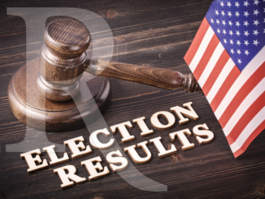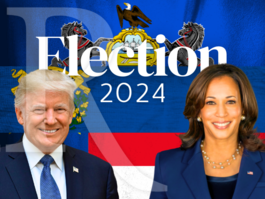Generic Congressional Ballot
GOP +3 on Final Generic Congressional Ballot: Sponsored by Miranda Devine's LAPTOP FROM HELL: Hunter Biden, Big Tech, and the Dirty Secrets the President Tried to Hide
As Election Day arrives, Republicans have a three-point lead in their battle to maintain their narrow House majority.
The latest Rasmussen Reports national telephone and online survey finds that in the elections for Congress, 48% of Likely U.S. Voters would vote for the Republican candidate, while 45% would vote for the Democrat. Just three percent (3%) would vote for some other candidate, but another four percent (4%) are not sure. (To see survey question wording, click here.)
The GOP’s advantage has increased slightly since October, when they led by two points – 47% to 47% – over Democrats. Two years ago, in the final poll before Election Day 2022, Republicans held a five-point lead, and scored a net gain of nine seats to capture a 222-213 House majority.
(Not getting our eNewsletter? Sign up HERE. Already signed up? Try adding [email protected] to your contacts or whitelisting us. Still having trouble – email [email protected]. If it's in the news, it's in our polls).
Rasmussen Reports updates are also available on Twitter or Facebook.
The survey of 1,809 U.S. Likely Voters was conducted on October 30-31 and November 3, 2024 by Rasmussen Reports. The margin of sampling error is +/- 2 percentage points with a 95% level of confidence. Field work for all Rasmussen Reports surveys is conducted by Pulse Opinion Research, LLC. See methodology.
The GOP’s lead on the generic ballot is mostly due to greater partisan intensity. Eighty-nine percent (89%) of Republicans would vote for their own party’s congressional candidate if the election were held today, while 84% of Democrats would vote for the Democratic candidate. Among voters not affiliated with either major party, 43% would vote Republican and 40% would vote Democrat, while eight percent (8%) say they’d vote for some other candidate and nine percent (9%) are undecided. In October, the GOP held a 10-point lead among independents.
The “gender gap” in the generic ballot remains relatively narrow, with men now favoring Republicans by a seven-point margin – 50% to 43% – while women voters are almost evenly divided, with 47% for Democrats to 46% for Republicans.
Voters under 40 prefer Democrats by a two-point margin – 46% to 44% – while those ages 40-64 favor Republicans by six points, 49% to 43%. Among voters 65 and older, 51% would vote GOP for Congress and 45% would vote for Democrats.
Fifty-one percent (51%) of whites, 29% of black voters, 53% of Hispanics and 50% of other minorities favor Republicans, while 44% of whites, 64% of black voters, 38% of Hispanics and 32% of other minorities would vote Democrat if the election were held today.
Eighty-four percent (84%) of self-identified liberal voters would vote for Democrats, while 76% of conservatives prefer Republican candidates for Congress. Among moderate voters, 51% favor Democrats and 39% would vote GOP.
Breaking down the electorate by income categories, 54% of voters earning more than $100,000 a year favor Democrats, while Republicans lead by 18 points, 55% to 37%, among those with annual incomes between $30,000 and $50,000.
Most voters worry that the outcome of this year’s election will not be known immediately because of delays in reporting results.
Trump has a three-point lead over Harris in our final national poll of the 2024 presidential election.
Additional information from this survey and a full demographic breakdown are available to Platinum Members only.
Please sign up for the Rasmussen Reports daily e-mail update (it’s free) or follow us on Facebook. Let us keep you up to date with the latest public opinion news.
The survey of 1,809 U.S. Likely Voters was conducted on October 30-31 and November 3, 2024 by Rasmussen Reports. The margin of sampling error is +/- 2 percentage points with a 95% level of confidence. Field
The survey of 1,809 U.S. Likely Voters was conducted on October 30-31 and November 3, 2024 by Rasmussen Reports. The margin of sampling error is +/- 2 percentage points with a 95% level of confidence. Field
Rasmussen Reports is a media company specializing in the collection, publication and distribution of public opinion information.
We conduct public opinion polls on a variety of topics to inform our audience on events in the news and other topics of interest. To ensure editorial control and independence, we pay for the polls ourselves and generate revenue through the sale of subscriptions, sponsorships, and advertising. Nightly polling on politics, business and lifestyle topics provides the content to update the Rasmussen Reports web site many times each day. If it's in the news, it's in our polls. Additionally, the data drives a daily update newsletter and various media outlets across the country.
Some information, including the Rasmussen Reports daily Presidential Tracking Poll and commentaries are available for free to the general public. Subscriptions are available for $4.95 a month or 34.95 a year that provide subscribers with exclusive access to more than 20 stories per week on upcoming elections, consumer confidence, and issues that affect us all. For those who are really into the numbers, Platinum Members can review demographic crosstabs and a full history of our data.
To learn more about our methodology, click here.






